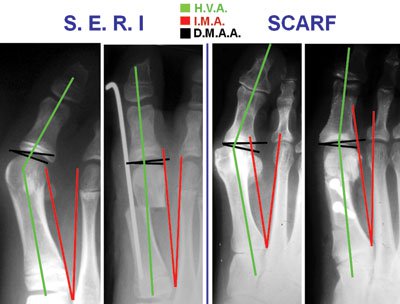Study shows benefits of SERI osteotomy for hallux valgus
A prospective randomized study revealed that use of a minimally invasive distal metatarsal osteotomy technique for patients with hallux valgus resulted in fewer complications, and was more cost-effective than the scarf technique.
Study investigator Sandro Giannini, MD, noted that both the scarf and minimally invasive simple, effective, rapid, inexpensive (SERI) techniques are versatile and allow for correction of hallux valgus deformities from all angles and provide access to the distal, frontal, transverse and sagittal planes — allowing complete correction of the pathoanatomy of the hallux valgus.
“SERI osteotomy is our favorite because it’s less invasive with lower complications, easier to perform after a learning curve of about 20 cases, faster and cheaper due to less surgical time and no need of hardware removal,” Giannini, who presented his team’s results at the 2011 Annual Meeting of the American Academy of Orthopaedic Surgeons, said.
Randomized treatment
Giannini and colleagues treated 20 women with hallux valgus who were treated with either the SERI or scarf osteotomy technique in either foot. The patients had a mean age of 53 years, and the degree of each deformity was similar in both feet.
The researchers performed clinical evaluations and obtained radiographs of the patients at 6-, 12-, 24-, 36- and 84-months follow-up.
The groups received the same postoperative treatment, which included gauze compression dressings and ambulation immediately after the use of talus shoes. After 1 month, the researchers allowed comfortable shoes, cycling and swimming.
|
Image: Giannini S |
Function
The researchers found no significant difference in AOFAS scores between the SERI and scarf groups. The preoperative AOFAS scores improved from 51 to 81 postoperatively in the SERI group and from 48 to 77 postoperatively in the scarf group.
In the SERI group, the hallux valgus angle improved from 35° to 21°, the intermetatarsal angle from 16° to 6° and the distal metatarsal angle from 21° to 15°. In the scarf group, the hallux valgus angle improved from 35° to 20°, the intermetatarsal angle from 16° to 8° and the distal metatarsal from 21° to 15°. All of the patients healed postoperatively.
Patients in both groups experienced increased arthritis from stage 1 to stage 2 and mild restricted range-of-motion at follow-up. Two patients who had the scarf technique required hardware removal, Giannini said.
Cost and surgical time
“You have to consider the time for surgery, effectiveness and rarity of complications” said Giannini. He found that surgeons performed the SERI technique in 3 minutes, while the scarf technique took 17 minutes. He noted that at $40 per minute, the surgeon saves $560 per surgery with the SERI technique.
Some patients may also prefer the SERI technique to the scarf procedure. Giannini found that eight patients chose the SERI rather than the scarf technique for their treatment.
“The SERI technique is simple, only a few steps, but you must pay attention to learn and perform the steps exactly,” Giannini said. – by Renee Blisard
Reference:
- Giannini S, Faldini C, Chiarello E, et al. Hallux valgus treatment: Comparative evaluation of SERI technique vs. SCARF at 7 year follow up. Paper #510. Presented at the 2011 Annual Meeting of the American Academy of Orthopaedic Surgeons. Feb. 15-19. San Diego.

- Sandro Giannini, MD, can be reached at Istituto Ortopedico Rizzoli, via GC Pupilli, 1, 40136 Bologna, Italy; +39 (51) 636-6827; email: sandro.giannini@ior.it.
- Disclosure: Giannini has no conflict of interest to disclose.
Dr. Giannini has been demonstrating the SERI bunionectomy for several years now, and his results are very good. Unfortunately, several surgeons in the United States have tried to duplicate his technique with inadequate results. I would personally love to visit Bologna to see the procedure and discern the fine points of the SERI, which will make all the difference between a good outcome and a poor one.
While a resident, I learned a complex metatarsal neck bunionectomy from Dr. Kent Wu, but have not performed that procedure because of the difficulty and worries of displacement. The SERI is a similarly deceptive operation— seemingly very easy, but also easy to malreduce.
Dr. Giannini compared the SERI to the SCARF procedure, which is enjoying a wave of popularity. The results were comparable and the study well done.
I traveled to England to learn the SCARF more than 10 years ago, but have abandoned that bunionectomy as well, preferring proximal opening wedge and chevron procedures now.
— Stuart D. Miller, MD
Department of
Orthopaedic Surgery
Union Memorial Hospital
Baltimore
Disclosure: He receives royalties from Biomet; is on the
speakers’ bureau/paid presentations for IntegraLifesciences; is a paid
consultant for Biomet and IntegraLifesciences; has stock or stock options in
Arthrocare, IntegraLifesciences, Osiris and Orthovita.


